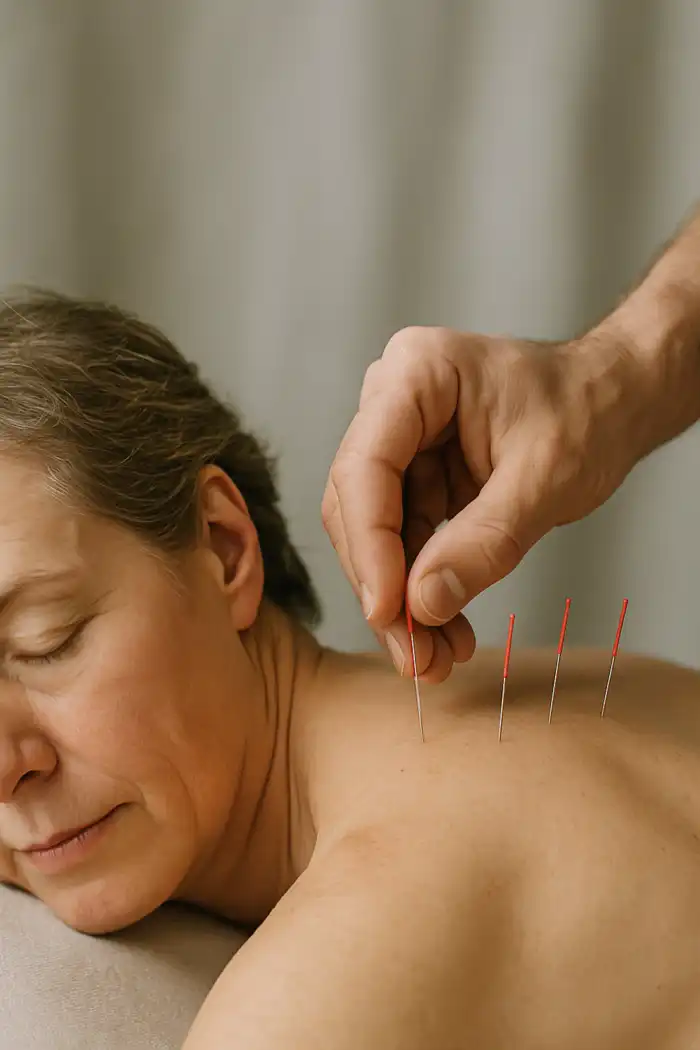Acupuncture Insights for Pain Relief

Posted on: 2025-04-22
By: Kaiya Whitmore
Acupuncture: A Holistic Pathway to Well-being
Acupuncture is not merely a method for pain relief; it offers a pathway to holistic well-being, rooted in thousands of years of history. As this ancient practice gains recognition in modern healthcare, understanding its principles can empower you to make informed decisions about your health and wellness journey.
What You Will Learn
- Historical Significance: Acupuncture dates back thousands of years, rooted in Traditional Chinese Medicine (TCM) principles that emphasize balance and harmony within the body.
- Evidence-Based Efficacy: Research supports acupuncture's effectiveness for managing various types of pain, including migraines, chronic back pain, and osteoarthritis.
- Holistic Approach: Acupuncture addresses not only the symptoms of pain but also its root causes, promoting a comprehensive view of patient care.
- Mechanistic Understanding: Acupuncture modulates pain pathways in the body, enhancing the release of endorphins and promoting relaxation, which aids in pain relief.
- Personalized Treatment: Acupuncture treatments can be tailored to individual needs, allowing for a more effective approach to pain management.
- Patient Experiences Matter: Insights from patient stories highlight how acupuncture can significantly improve quality of life beyond mere pain relief.
- Trends in Integration: There’s a growing collaboration between acupuncturists and conventional medicine, recognizing acupuncture as a viable complementary therapy.
Insights on Acupuncture for Pain Management
Key findings from recent evidence highlight acupuncture's effectiveness in managing various types of pain, including chronic back pain, migraines, and osteoarthritis. Below is a visual representation of the evidence and mechanisms associated with acupuncture.
Conditions Treated
- Chronic Back Pain
- Migraine Headaches
- Osteoarthritis
- Neuropathic Pain
Mechanisms of Action
- Regulate Pain Perception
- Enhance Endorphin Release
- Promote Relaxation
- Reduce Stress Levels
Evidence-Based Support
Positive Outcomes for:
- Chronic Pain Management
- Holistic Health Approaches
- Patient Quality of Life
Comprehensive Overview of Acupuncture for Pain Management
Acupuncture is an ancient practice that has garnered attention for its potential role in pain management. For many, it’s not just about relieving pain; it’s about restoring balance and enhancing overall well-being. With my background in traditional medicine, I’m excited to share insights into how acupuncture has evolved and its significance in modern healthcare.
This overview will explore acupuncture's historical roots, its importance today, and how traditional Chinese medicine (TCM) principles guide its application in alleviating pain. Understanding these aspects can help us appreciate the depth of this healing art and its ongoing relevance in our wellness journeys.
Understanding Acupuncture: A Historical Perspective
Let’s take a step back to understand the origins of acupuncture. This practice dates back thousands of years in China, where it was used to manage various health issues. The ancient texts illustrate a rich tapestry of knowledge regarding the body's energy pathways and the balance of yin and yang, forming the foundation of acupuncture therapy. For a deeper dive into the benefits of acupuncture, check out our article on insights on acupuncture benefits.
Over the years, acupuncture has evolved and adapted to different cultures and medical practices. Today, it is recognized worldwide as a viable treatment option for many health conditions. As we look at its journey, we can see how acupuncture has retained its core principles while integrating modern scientific understandings.
The Origins and Evolution of Acupuncture Therapy
The earliest records of acupuncture can be traced to the Huangdi Neijing, an ancient Chinese medical text. This work lays the groundwork for TCM, emphasizing the interconnectedness of body systems and the importance of restoring harmony. As techniques evolved, acupuncture began to incorporate various styles and methodologies, reflecting local beliefs and practices.
In recent decades, acupuncture has gained traction outside of Asia, especially in Western countries. It’s fascinating to see how this ancient practice has sparked interest in evidence-based research, proving its efficacy in treating various ailments, particularly pain management.
Acupuncture's Role in Non-Pharmacological Pain Relief
In today’s context, where chronic pain and opioid dependence are pressing issues, acupuncture presents a non-pharmacological option worth considering. It’s not just about treating the symptoms; acupuncture aims to address the root causes of pain, emphasizing a holistic approach to health.
Many patients have turned to acupuncture as a way to find relief without the side effects associated with medications. This trend is encouraging, as it promotes a more natural and less invasive method of pain management. The journey of healing through acupuncture can often lead to a deeper understanding of one’s health and well-being.
Significance of Acupuncture in Modern Pain Management
Acupuncture’s significance in the realm of pain management cannot be overstated. It plays a crucial role in providing relief for various conditions, offering an alternative or complement to conventional treatments. It’s exciting to witness the growing acceptance of acupuncture among healthcare professionals and patients alike. To learn more about acupuncture's integration into Western medicine, read our article on acupuncture's role in Western medicine.
As we explore how acupuncture fits into modern healthcare frameworks, we can begin to appreciate its adaptability and effectiveness as a pain management strategy. Understanding patient perspectives is equally important, as it shapes our approach to holistic health solutions.
Trends in Chronic Pain Management Approaches
Chronic pain is a complex condition that often requires a multifaceted approach. Here are some key trends in how acupuncture is being integrated into pain management:
- Increased collaboration between acupuncturists and conventional medical practitioners.
- Growing recognition of acupuncture as a complementary therapy in chronic pain protocols.
- Research-driven approaches that validate acupuncture’s effectiveness through clinical trials.
These trends reflect a shift in recognizing the value of holistic health strategies, which is a cornerstone of what we advocate at Acupuncture Perspectives. Our platform aims to bridge traditional wisdom with modern wellness practices, fostering a deeper understanding of acupuncture's benefits.
Patient Perspectives on Acupuncture as a Treatment Option
Patient experiences with acupuncture can be incredibly insightful. Many individuals share stories of how acupuncture has transformed their lives, providing relief when other treatments failed. This personal touch enriches the narrative around acupuncture and highlights its importance in pain management. For compelling real-life stories of healing through acupuncture, see our article: Healing Through Acupuncture: Real Stories.
When speaking with patients, I often hear a common sentiment: acupuncture is not just about alleviating pain; it’s about enhancing their quality of life. This holistic impact is what makes acupuncture a compelling option for many seeking alternative therapies. Their stories remind us of the transformative power of traditional practices in contemporary health care.
Traditional Chinese Medicine and Acupuncture
At the heart of acupuncture lies the principles of Traditional Chinese Medicine (TCM). Understanding these concepts can provide a clearer picture of how acupuncture works in managing pain and promoting overall health. TCM offers a unique lens through which we can view the body and its functions, emphasizing balance and harmony. For a comprehensive understanding of acupuncture and its connection to TCM, explore our article: Understanding Acupuncture and Chinese Medicine.
The integration of TCM principles into acupuncture practices allows for tailored treatment plans that cater to individual needs. This personalized approach is vital for achieving optimal outcomes and fostering a deeper connection between acupuncturists and their patients.
Fundamentals of TCM Theory in Pain Management
TCM is based on several core concepts, including:
- Yin and Yang: The balance between opposing forces in the body.
- Qi: The vital energy that flows through meridians.
- Five Elements: Wood, Fire, Earth, Metal, and Water, which correspond to different body functions.
These fundamentals guide practitioners in diagnosing and treating pain, focusing on restoring harmony within the body. By embracing these principles, acupuncturists can create more effective treatment plans that resonate with patients' needs.
The Role of Qi and Meridians in Acupuncture Therapy
In TCM, Qi is believed to flow through meridians, or energy pathways, connecting various body parts. When Qi is obstructed or imbalanced, it can lead to pain and other health issues. Acupuncture aims to restore the smooth flow of Qi, alleviating discomfort and promoting healing.
By targeting specific acupuncture points along these meridians, practitioners can influence the body's energy and facilitate pain relief. This approach highlights the importance of understanding the body's interconnectedness, which is a key tenet of TCM.
Quick Summary
Here's a brief recap of the key points discussed so far:
- Acupuncture has ancient roots in Traditional Chinese Medicine, focusing on restoring balance and promoting overall well-being.
- It serves as a non-pharmacological pain relief option, addressing root causes rather than just symptoms.
- Patient perspectives highlight acupuncture's transformative impact on quality of life, reinforcing its relevance in modern healthcare.
Summary of Insights on Acupuncture for Pain Management
As we wrap up our exploration of acupuncture for pain management, it's essential to highlight the key insights we've gathered along the way. Acupuncture is not just a treatment; it’s a holistic approach that resonates with many seeking relief from various types of pain. The evidence supporting acupuncture's role in pain relief is compelling, reflecting its growing acceptance in healthcare practices worldwide. For instance, studies have shown that acupuncture can significantly reduce chronic pain and improve the quality of life for patients, making it a valuable addition to pain management protocols.
Moreover, understanding the mechanisms behind acupuncture enhances our appreciation of how this ancient practice works. By modulating neuronal activity and engaging biochemical pathways, acupuncture helps to decrease pain perception and promote healing. As patients, it's crucial to realize that the benefits of acupuncture extend beyond just immediate relief; they often include long-term improvements in overall well-being.
Key Takeaways on Acupuncture Effectiveness and Mechanisms
Here are some key takeaways to consider:
- Evidence-Based Support: Numerous studies affirm acupuncture's effectiveness in managing pain, particularly for conditions like migraines, osteoarthritis, and chronic back pain.
- Mechanistic Insights: Acupuncture influences the body’s pain pathways, including the release of endorphins and the modulation of cortisol levels, which are essential for pain relief.
- Holistic Approach: This practice aligns well with various healthcare models, emphasizing a comprehensive view of patient care.
At Acupuncture Perspectives, we believe it’s vital for patients to be informed about these findings, as they empower individuals to make educated decisions regarding their health. Have you ever considered how a single treatment can intertwine with your overall wellness journey? It’s fascinating!
Recap of Evidence Supporting Acupuncture's Role in Pain Relief
Throughout this article, we have seen solid evidence supporting acupuncture's role in alleviating pain. The systematic reviews and clinical studies consistently report positive outcomes for various pain conditions. For example, acupuncture has shown significant effectiveness in providing relief for patients suffering from:
- Chronic back pain
- Migraine headaches
- Osteoarthritis
- Neuropathic pain
This underscores acupuncture's importance as a viable alternative or complement to traditional pain management strategies. As we continue to dive deeper into the world of acupuncture, it's our hope that more individuals will embrace this holistic option for their health challenges.
Understanding the Mechanisms Enhancing Treatment Outcomes
Understanding how acupuncture works is critical for appreciating its benefits. The practice taps into the body’s natural healing mechanisms, helping to:
- Regulate pain perception through neuronal modulation
- Enhance the release of natural pain-relieving compounds like endorphins
- Promote relaxation and reduce stress levels, which can further aid in pain relief
By recognizing these mechanisms, patients can feel more confident in the effectiveness of acupuncture as they incorporate it into their pain management plans. It’s all about aligning body and mind for a healthier you!
Recommendations for Patients Considering Acupuncture
If you're considering acupuncture, here are some helpful tips to ensure you have a positive experience:
- Choose a Qualified Practitioner: Look for licensed acupuncturists with good reviews and a background in treating your specific condition.
- Set Realistic Expectations: Understand that while many see improvement, results can vary from person to person. It may take multiple sessions to experience the full benefits.
- Communicate Openly: Discuss your health history and any concerns with your acupuncturist to tailor treatments effectively.
At Acupuncture Perspectives, we’re dedicated to providing comprehensive resources that empower individuals like you to explore acupuncture’s potential in your personal health journey. So, are you ready to discover how this ancient practice can transform your approach to pain management? To gain a global perspective on acupuncture practices, read our article on global perspectives on acupuncture.
Encouraging Informed Decisions Through Comprehensive Resources
Lastly, I encourage everyone to explore reliable resources to better understand acupuncture. Whether you’re reading expert insights or checking out case studies, knowledge is empowering! Seek out information that reflects the latest research and patient experiences. Websites, articles, and community discussions can provide valuable insights into what to expect from acupuncture.
As always, I invite you to join the conversation. Have you had any experiences with acupuncture that you’d like to share? Your stories can help others on their path to wellness and encourage a more significant dialogue around this transformative practice!
Recap of Key Points
Here is a quick recap of the important points discussed in the article:
- Historical Significance: Acupuncture has a rich history dating back thousands of years in China, rooted in Traditional Chinese Medicine (TCM) principles.
- Holistic Approach to Pain Management: Acupuncture emphasizes treating the root causes of pain, providing a non-pharmacological alternative to conventional pain relief methods.
- Evidence of Efficacy: Numerous studies support acupuncture's effectiveness in managing various pain conditions, including chronic back pain and migraines.
- Understanding Mechanisms: Acupuncture enhances pain relief by modulating neuronal activity and promoting the release of endorphins.
- Personalized Treatment: Integrating TCM principles allows acupuncturists to tailor treatment plans to individual patient needs, enhancing outcomes.
- Patient Experiences: Many individuals report significant improvements in their quality of life through acupuncture, highlighting its transformative potential.
- Recommendations for Patients: Consult qualified practitioners, set realistic expectations, and maintain open communication to maximize the benefits of acupuncture.
Frequently Asked Questions (FAQs)
Q: What is acupuncture?
A: Acupuncture is a traditional Chinese medicine technique involving the insertion of thin needles into specific points on the body to stimulate energy flow and promote healing.
Q: Is acupuncture effective for pain relief?
A: Research suggests acupuncture is effective for various pain conditions, including migraines, back pain, and osteoarthritis. However, individual results may vary.
Q: How does acupuncture work?
A: Acupuncture works by modulating pain pathways, releasing endorphins, and promoting relaxation, among other mechanisms. The exact mechanisms are still being researched.
Q: Is acupuncture safe?
A: When performed by a licensed and qualified practitioner, acupuncture is generally safe. It's crucial to discuss any health concerns with your practitioner before treatment.
Q: What should I expect during an acupuncture session?
A: During an acupuncture session, thin needles are inserted into specific points. Most people report feeling little to no discomfort. The experience can be relaxing and may lead to a sense of well-being.
Q: How many acupuncture sessions are needed?
A: The number of sessions needed varies depending on individual needs and conditions. Your acupuncturist will develop a personalized treatment plan.
 Acupuncture, an ancient practice with roots in Traditional Chinese Medicine, has transcended cultura
Acupuncture, an ancient practice with roots in Traditional Chinese Medicine, has transcended cultura
 As the demand for alternative therapies grows, the need for well-trained acupuncturists becomes para
As the demand for alternative therapies grows, the need for well-trained acupuncturists becomes para
 As global health trends evolve, ancient practices like acupuncture are finding their place in modern
As global health trends evolve, ancient practices like acupuncture are finding their place in modern